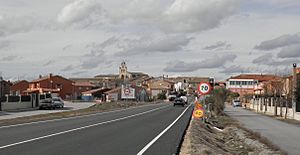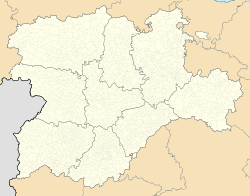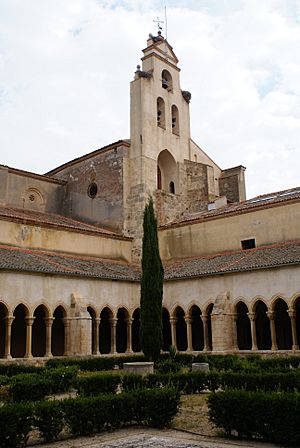Santa María la Real de Nieva facts for kids
Quick facts for kids
Santa María la Real de Nieva
|
|||
|---|---|---|---|
 |
|||
|
|||
| Country | |||
| Autonomous community | |||
| Province | |||
| Municipality | Santa María la Real de Nieva | ||
| Area | |||
| • Total | 198 km2 (76 sq mi) | ||
| Elevation | 907 m (2,976 ft) | ||
| Population
(2018)
|
|||
| • Total | 999 | ||
| • Density | 5.045/km2 (13.07/sq mi) | ||
| Time zone | UTC+1 (CET) | ||
| • Summer (DST) | UTC+2 (CEST) | ||
Santa María la Real de Nieva is a cool town (called a municipality) in Spain. It's in the Segovia province, which is part of the Castile and León region. This town is about 30 kilometers (18 miles) northwest of Segovia city. Back in 2010, about 1,193 people lived there.
Contents
Exploring the Villages of Santa María la Real de Nieva
This municipality is made up of 14 smaller villages. They are:
- Aragoneses
- Balisa
- Hoyuelos
- Jemenuño
- Laguna Rodrigo
- Miguel Ibáñez
- Ochando
- Paradinas
- Pascuales
- Pinilla-Ambroz
- Santa María la Real de Nieva (the main village)
- Santovenia
- Tabladillo
- Villoslada
The Fascinating History of the Town
Most of these villages were settled again in the 11th century. This happened after the Reconquista, a time when Christian kingdoms took back land from Muslim rule in Spain. King Alfonso VI of León and Castile was in charge then.
The main village, Santa María la Real de Nieva, was started later in 1395. King Henry III of Castile and his wife, Catherine of Lancaster, helped make it happen.
How Santa María la Real de Nieva Began
The town was founded because of a special discovery. Three years before, people found a wooden statue of Mary buried in the ground. It was probably hidden during the Muslim invasion. People thought finding it was a miracle!
Queen Catherine ordered a special church (called a sanctuary) and a village to be built around it. This was to honor the statue, which they called Soterraña. This old Spanish word means 'subterranean' or 'underground'. The King and Queen gave special benefits to people who moved to the new village in 1395 and 1407. These benefits included not having to pay certain taxes or join the army.
Important Events in History
- In 1441, Queen Blanche I of Navarre passed away while staying in Santa María la Real de Nieva. She was buried in the town's church.
- On October 28, 1473, King Henry IV of Castile held an important meeting of the Courts of Castile (like a parliament) at Santa Maria's monastery.
- During the revolt of the Comuneros in 1520, a leader of the royal troops, Rodrigo Ronquillo, set up his base here. However, his troops lost a battle close to the town.
In 1834, Spain changed how its areas were organized. Santa María la Real de Nieva became one of five legal districts in the Segovia Province.
Over time, the municipality of Santa María la Real de Nieva grew bigger. It added many of the nearby villages:
- Ochando and Pascuales joined in 1965.
- Aragoneses, Balisa, Hoyuelos, Laguna Rodrigo, Miguel Ibañez, Pinilla-Ambroz, Tabladillo, and Villoslada joined in 1969.
- Jemenuño, Santovenia, and Paradinas joined in 1970.
Amazing Monuments to See
There are three very important national monuments in this municipality. They are called Bien de Interés Cultural, which means 'Property of Cultural Interest'.
- Monastery of Our Lady of Soterraña: This monastery is in the main town of Santa María la Real de Nieva. It's a Gothic building from the 15th century. People especially admire its cloister (a covered walkway) and its front entrance.
- Chapel of Saint Michael: This small Romanesque church is in the village of Villoslada. It was built a long time ago, between the 12th and 13th centuries.
- Church of Our Lady of Assumption: You can find this church in Paradinas. It's a Gothic building from the 16th century, but it also has some neoclassical design elements.
See also
 In Spanish: Santa María la Real de Nieva para niños
In Spanish: Santa María la Real de Nieva para niños







